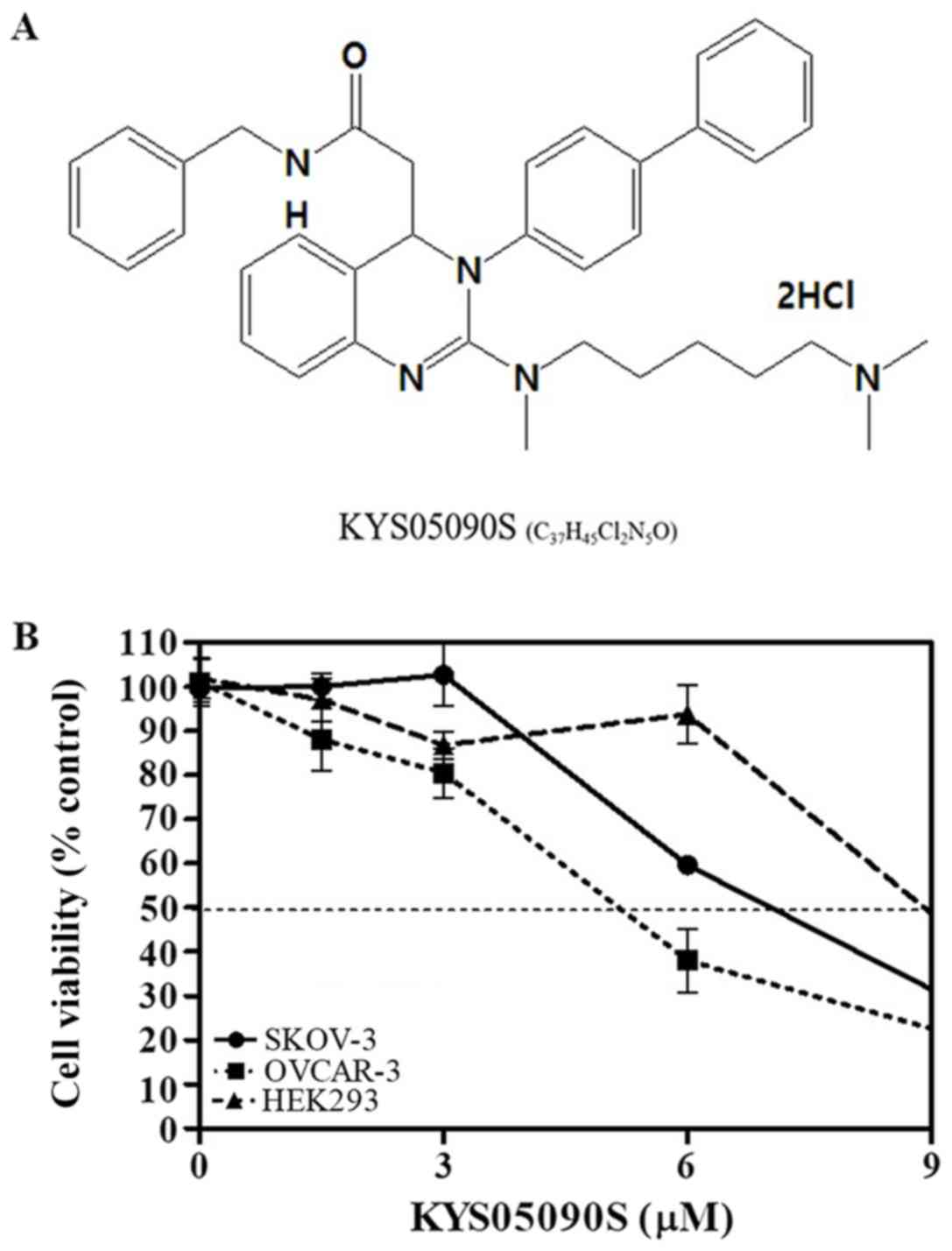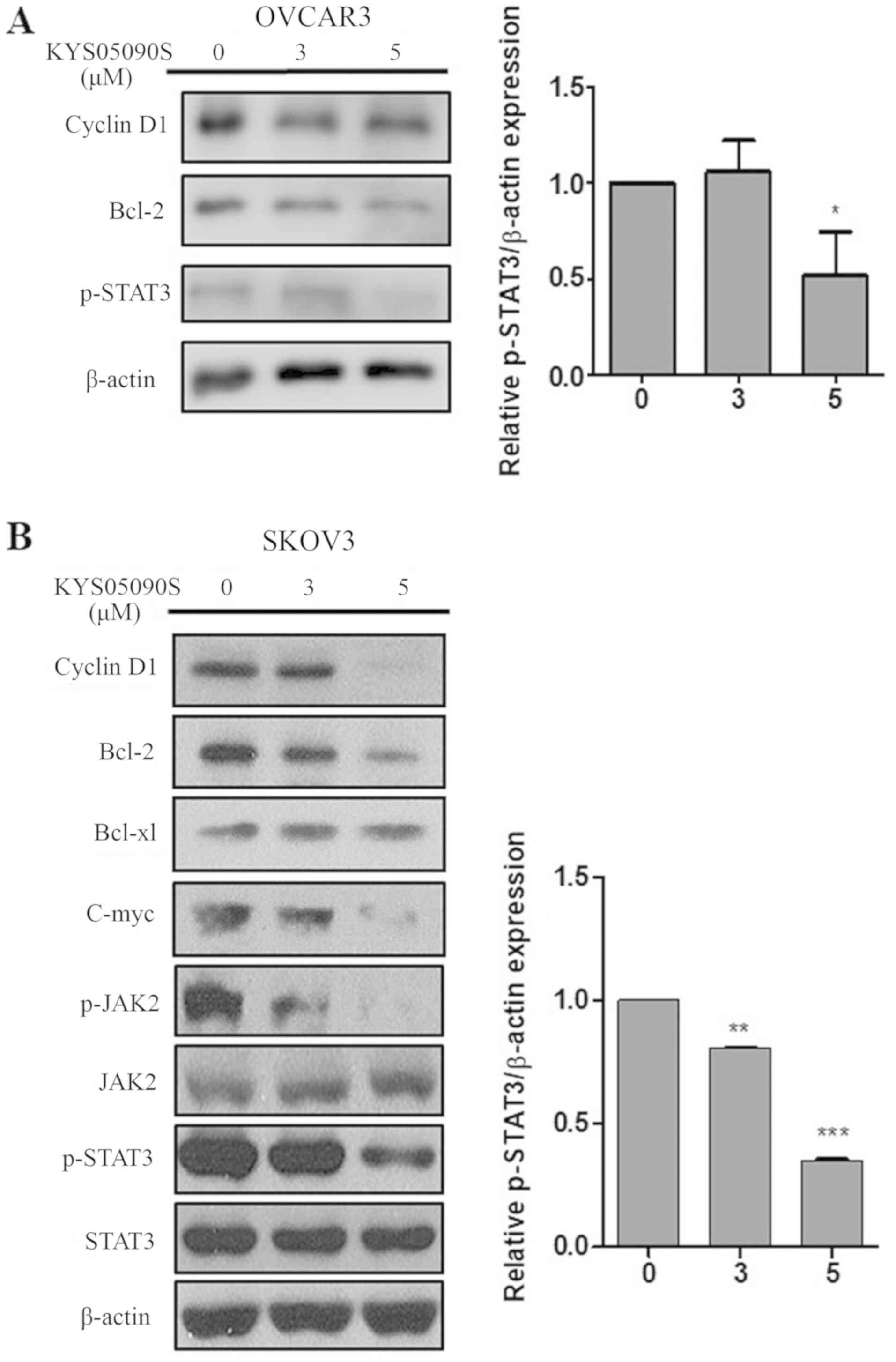|
1
|
Coward JI, Middleton K and Murphy F: New
perspectives on targeted therapy in ovarian cancer. Int J Womens
Health. 7:189–203. 2015. View Article : Google Scholar : PubMed/NCBI
|
|
2
|
Yan H, Guo BY and Zhang S:
Cancer-associated fibroblasts attenuate Cisplatin-induced apoptosis
in ovarian cancer cells by promoting STAT3 signaling. Biochem
Biophys Res Commun. 470:947–954. 2016. View Article : Google Scholar : PubMed/NCBI
|
|
3
|
Lim HJ and Ledger W: Targeted therapy in
ovarian cancer. Wom Health Lond. 12:363–378. 2016. View Article : Google Scholar
|
|
4
|
Dai L, Xia P and Di W: Sphingosine
1-phosphate: A potential molecular target for ovarian cancer
therapy? Cancer Invest. 32:71–80. 2014. View Article : Google Scholar : PubMed/NCBI
|
|
5
|
Mabuchi S, Kuroda H, Takahashi R and
Sasano T: The PI3K/AKT/mTOR pathway as a therapeutic target in
ovarian cancer. Gynecol Oncol. 137:173–179. 2015. View Article : Google Scholar : PubMed/NCBI
|
|
6
|
Cheaib B, Auguste A and Leary A: The
PI3K/Akt/mTOR pathway in ovarian cancer: Therapeutic opportunities
and challenges. Chin J Cancer. 34:4–16. 2015. View Article : Google Scholar : PubMed/NCBI
|
|
7
|
Zhang S, Cui B, Lai H, Liu G, Ghia EM,
Widhopf GF II, Zhang Z, Wu CC, Chen L, Wu R, et al: Ovarian cancer
stem cells express ROR1, which can be targeted for
anti-cancer-stem-cell therapy. Proc Natl Acad Sci USA.
111:17266–17271. 2014. View Article : Google Scholar : PubMed/NCBI
|
|
8
|
Horvath CM: STAT proteins and
transcriptional responses to extracellular signals. Trends Biochem
Sci. 25:496–502. 2000. View Article : Google Scholar : PubMed/NCBI
|
|
9
|
Siddiquee K, Zhang S, Guida WC, Blaskovich
MA, Greedy B, Lawrence HR, Yip ML, Jove R, McLaughlin MM, Lawrence
NJ, et al: Selective chemical probe inhibitor of Stat3, identified
through structure-based virtual screening, induces antitumor
activity. Proc Natl Acad Sci USA. 104:7391–7396. 2007. View Article : Google Scholar : PubMed/NCBI
|
|
10
|
Rim HK, Cho S, Shin DH, Chung KS, Cho YW,
Choi JH, Lee JY and Lee KT: T-type Ca2+ channel blocker,
KYS05090 induces autophagy and apoptosis in A549 cells through
inhibiting glucose uptake. Molecules. 19:9864–9875. 2014.
View Article : Google Scholar : PubMed/NCBI
|
|
11
|
Dziegielewska B, Gray LS and Dziegielewski
J: T-type calcium channels blockers as new tools in cancer
therapies. Pflugers Arch. 466:801–810. 2014. View Article : Google Scholar : PubMed/NCBI
|
|
12
|
Jang SJ, Choi HW, Choi DL, Cho S, Rim HK,
Choi HE, Kim KS, Huang M, Rhim H, Lee KT, et al: In vitro
cytotoxicity on human ovarian cancer cells by T-type calcium
channel blockers. Bioorg Med Chem Lett. 23:6656–6662. 2013.
View Article : Google Scholar : PubMed/NCBI
|
|
13
|
Jung SY, Lee SH, Kang HB, Park HA, Chang
SK, Kim J, Choo DJ, Oh CR, Kim YD, Seo JH, et al: Antitumor
activity of 3,4-dihydroquinazoline dihydrochloride in A549
xenograft nude mice. Bioorg Med Chem Lett. 20:6633–6636. 2010.
View Article : Google Scholar : PubMed/NCBI
|
|
14
|
Byun JS, Sohn JM, Leem DG, Park B, Nam JH,
Shin DH, Shin JS, Kim HJ, Lee KT and Lee JY: In vitro synergistic
anticancer activity of the combination of T-type calcium channel
blocker and chemotherapeutic agent in A549 cells. Bioorg Med Chem
Lett. 26:1073–1079. 2016. View Article : Google Scholar : PubMed/NCBI
|
|
15
|
Telford WG, King LE and Fraker PJ:
Comparative evaluation of several DNA binding dyes in the detection
of apoptosis-associated chromatin degradation by flow cytometry.
Cytometry. 13:137–143. 1992. View Article : Google Scholar : PubMed/NCBI
|
|
16
|
Wang SW and Sun YM: The IL-6/JAK/STAT3
pathway: Potential therapeutic strategies in treating colorectal
cancer (Review). Int J Oncol. 44:1032–1040. 2014. View Article : Google Scholar : PubMed/NCBI
|
|
17
|
Shinagawa K, Yanamoto S, Naruse T,
Kawakita A, Morishita K, Sakamoto Y, Rokutanda S and Umeda M:
Clinical roles of interleukin-6 and STAT3 in oral squamous cell
carcinoma. Pathol Oncol Res. 23:425–431. 2017. View Article : Google Scholar
|
|
18
|
Ni CW, Hsieh HJ, Chao YJ and Wang DL:
Interleukin-6-induced JAK2/STAT3 signaling pathway in endothelial
cells is suppressed by hemodynamic flow. Am J Physiol Cell Physiol.
287:C771–C780. 2004. View Article : Google Scholar : PubMed/NCBI
|
|
19
|
Zhang HF and Lai R: STAT3 in cancer-friend
or foe? Cancers (Basel). 6:1408–1440. 2014. View Article : Google Scholar
|
|
20
|
Aravantinos G and Pectasides D:
Bevacizumab in combination with chemotherapy for the treatment of
advanced ovarian cancer: A systematic review. J Ovarian Res.
7:572014. View Article : Google Scholar : PubMed/NCBI
|
|
21
|
Sopik V, Rosen B, Giannakeas V and Narod
SA: Why have ovarian cancer mortality rates declined? Part III
Prospects for the future. Gynecol Oncol. 138:757–761. 2015.
View Article : Google Scholar : PubMed/NCBI
|
|
22
|
Liu J and Matulonis UA: New strategies in
ovarian cancer: Translating the molecular complexity of ovarian
cancer into treatment advances. Clin Cancer Res. 20:5150–5156.
2014. View Article : Google Scholar : PubMed/NCBI
|
|
23
|
Kiraz Y, Adan A, Kartal Yandim M and Baran
Y: Major apoptotic mechanisms and genes involved in apoptosis.
Tumour Biol. 37:8471–8486. 2016. View Article : Google Scholar : PubMed/NCBI
|
|
24
|
Lesinski GB, Raig ET, Guenterberg K, Brown
L, Go MR, Shah NN, Lewis A, Quimper M, Hade E, Young G, et al:
IFN-alpha and bortezomib overcome Bcl-2 and Mcl-1 overexpression in
melanoma cells by stimulating the extrinsic pathway of apoptosis.
Cancer Res. 68:8351–8360. 2008. View Article : Google Scholar : PubMed/NCBI
|
|
25
|
Fadeel B and Orrenius S: Apoptosis: A
basic biological phenomenon with wide-ranging implications in human
disease. J Intern Med. 258:479–517. 2005. View Article : Google Scholar : PubMed/NCBI
|
|
26
|
Hata AN, Engelman JA and Faber AC: The
BCL2 Family: Key mediators of the apoptotic response to targeted
anticancer therapeutics. Cancer Discov. 5:475–487. 2015. View Article : Google Scholar : PubMed/NCBI
|
|
27
|
Imada K and Leonard WJ: The Jak-STAT
pathway. Mol Immunol. 37:1–11. 2000. View Article : Google Scholar : PubMed/NCBI
|
|
28
|
Matsui F and Meldrum KK: The role of the
Janus kinase family/signal transducer and activator of
transcription signaling pathway in fibrotic renal disease. J Surg
Res. 178:339–345. 2012. View Article : Google Scholar : PubMed/NCBI
|
|
29
|
Wang X, Crowe PJ, Goldstein D and Yang JL:
STAT3 inhibition, a novel approach to enhancing targeted therapy in
human cancers (Review). Int J Oncol. 41:1181–1191. 2012. View Article : Google Scholar : PubMed/NCBI
|
|
30
|
Jung IH, Choi JH, Chung YY, Lim GL, Park
YN and Park SW: Predominant activation of JAK/STAT3 pathway by
interleukin-6 is implicated in hepatocarcinogenesis. Neoplasia.
17:586–597. 2015. View Article : Google Scholar : PubMed/NCBI
|
|
31
|
Kitamura H, Kamon H, Sawa S, Park SJ,
Katunuma N, Ishihara K, Murakami M and Hirano T: IL-6-STAT3
controls intracellular MHC class II alphabeta dimer level through
cathepsin S activity in dendritic cells. Immunity. 23:491–502.
2005. View Article : Google Scholar : PubMed/NCBI
|
|
32
|
Knüpfer H and Preiss R: Serum
interleukin-6 levels in colorectal cancer patients--a summary of
published results. Int J Colorectal Dis. 25:135–140. 2010.
View Article : Google Scholar
|
|
33
|
Chung CD, Liao J, Liu B, Rao X, Jay P,
Berta P and Shuai K: Specific inhibition of Stat3 signal
transduction by PIAS3. Science. 278:1803–1805. 1997. View Article : Google Scholar : PubMed/NCBI
|
|
34
|
Kim JH, Jeong HR, Jung DW, Yoon HB, Kim
SY, Kim HJ, Lee KT, Gadotti VM, Huang J, Zhang FX, et al: Synthesis
and biological evaluation of fluoro-substituted
3,4-dihydroquin-azoline derivatives for cytotoxic and analgesic
effects. Bioorg Med Chem. 25:4656–4664. 2017. View Article : Google Scholar : PubMed/NCBI
|
















